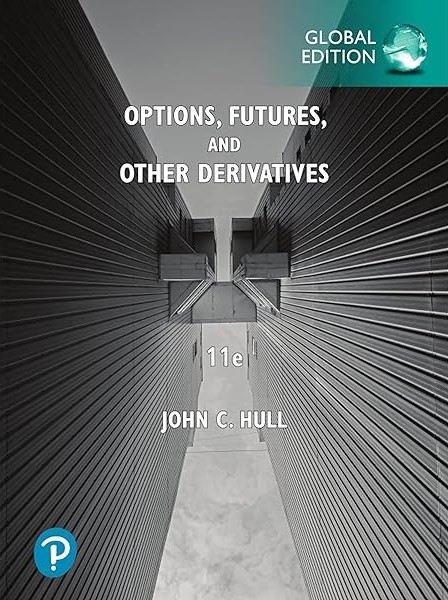Options, Futures, and Other Derivatives, Global Edition By John Hull

1 C H A P T E R
Introduction
In the last 40 years, derivatives have become increasingly important in finance. Futures
and options are actively traded on many exchanges throughout the world. Many
different types of forward contracts, swaps, options, and other derivatives are entered
into by financial institutions, fund managers, and corporate treasurers in the over-thecounter
market. Derivatives are added to bond issues, used in executive compensation
plans, embedded in capital investment opportunities, used to transfer risks in mortgages
from the original lenders to investors, and so on. We have now reached the stage where
those who work in finance, and many who work outside finance, need to understand
how derivatives work, how they are used, and how they are priced.
Whether you love derivatives or hate them, you cannot ignore them! The derivatives
market is huge—much bigger than the stock market when measured in terms of
underlying assets. The value of the assets underlying outstanding derivatives transactions
is several times the world gross domestic product. As we shall see in this chapter,
derivatives can be used for hedging or speculation or arbitrage. They can transfer a wide
range of risks in the economy from one entity to another.
A derivative involves two parties agreeing to a future tranasaction. Its value depends
on (or derives from) the values of other underlying variables. Very often the variables
underlying derivatives are the prices of traded assets. A stock option, for example, is a
derivative whose value is dependent on the price of a stock. However, derivatives can be
dependent on almost any variable, from the price of hogs to the amount of snow falling
at a certain ski resort.
Since the first edition of this book was published in 1988 there have been many
developments in derivatives markets. For example:
• Many new instruments such as credit derivatives, electricity derivatives, weather
derivatives, and insurance derivatives have been developed.
• Many new types of interest rate, foreign exchange, and equity derivatives now
trade.
• There have been many new ideas in risk management and risk measurement.
• Real option methods for capital investment appraisal have been developed.
• The financial crisis of 2008 occurred, with derivatives (perhaps unfairly) getting
much of the blame.
• Many regulations affecting the over-the-counter derivatives market have been
introduced.
• The “risk-free” discount rate used to value derivatives has changed and the
decision has been taken to phase out LIBOR.
• Derivatives dealers now adjust the way they price derivatives to allow for credit
risks, funding costs, and capital requirements.
• Collateral and credit issues are now given much more attention and have led to
changes in the way derivatives are traded.
• Machine learning is now becoming widely used for managing derivatives
portfolios.
The book has evolved to keep up to date with these developments. For example: the
2008 financial crisis is discussed in Chapter 8; changes in the interest rates used for
derivatives pricing are discussed in Chapter 4; valuation adjustments are covered in
Chapter 9; real options are explained in Chapter 36; credit derivatives are covered in
Chapter 25; energy, weather, and insurance derivatives are covered in Chapter 35.
Machine learning applications are discussed at various points in the book.
In this opening chapter, we take a first look at derivatives markets and how they are
changing. We contrast exchange-traded and over-the-counter derivatives markets and
review recent regulatory changes affecting the markets. We describe forward, futures,
and options markets and provide examples of how they are used by hedgers, speculators,
and arbitrageurs. Later in the book we will elaborate on many of the points
made in this chapter.
A derivatives exchange is a market where individuals and companies trade standardized
contracts that have been defined by the exchange. Derivatives exchanges have
existed for a long time. The Chicago Board of Trade (CBOT) was established in 1848
to bring farmers and merchants together. Initially its main task was to standardize
the quantities and qualities of the grains that were traded. Within a few years, the
first futures-type contract was developed. It was known as a to-arrive contract.
Speculators soon became interested in the contract and found trading the contract
to be an attractive alternative to trading the grain itself. A rival futures exchange, the
Chicago Mercantile Exchange (CME), was established in 1919. Now futures exchanges
exist all over the world. (See table at the end of the book.) The CME
and CBOT have merged to form the CME Group (www.cmegroup.com), which also
includes the New York Mercantile Exchange (NYMEX), and the Kansas City Board
of Trade (KCBT).
The Chicago Board Options Exchange (CBOE, www.cboe.com) started trading call
option contracts on 16 stocks in 1973. Options had traded prior to 1973, but the CBOE
succeeded in creating an orderly market with well-defined contracts. Put option
contracts started trading on the exchange in 1977. The CBOE now trades options on
thousands of stocks and many different stock indices. Like futures, options have proved
to be very popular contracts. Many other exchanges throughout the world now trade
Options, Futures, and Other Derivatives, Global Edition By John Hull




